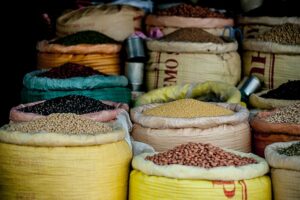LEGUMES: SUSTAINABLE NUTRITION

The legume family includes beans, peas and lentils. There are so many different varieties, and they can be prepared, eaten and enjoyed in so many different ways, depending on where you live in the world, your cultural heritage, cooking skills and personal food preferences.
Our most commonly used word for legumes is “bean” and the Roman’s was “faba”—but they actually have a common ancestor, the Indo-European bhabh or bhabha which means “swollen” or “swelling”. We think whoever had naming rights on this was spot on—beans are very generous providers, swelling up in the cooking pot so that one cup of dried beans gives us two or three cups to serve up. So, it’s no wonder they have made themselves at home in kitchens around the world in classic dishes, family favourites and vegetarian fare. Not only do they bulk things out, they thicken, add texture and colour, absorb flavours, make great partners, and are nourishing, frugal extenders making a little go a very long way.
Legumes also have a long shelf life – it’s as if they don’t have a use-by date! Archaeologists have found perfectly preserved seeds in Peru and Mexico dating back about 4000 years (they didn’t eat them, they put them in a museum).
Filling bellies, tasting good and keeping for a long time—this family hits the trifecta, so it was only natural people around the world would want to grow beans, peas, and lentils. Millennia ago, our forebears planted out their seeds in the Old World and the New—where they also came up with a multi-cropping system, growing beans along with maize (corn) and winter squash in their fields. This both boosted plant productivity and enriched the soil.
Our farming forebears didn’t know about nitrogen-fixing bacteria, but they did know that growing beans, peas and lentils put food on the table and helped other crops grow and thrive. Rotating crops is probably as old as agriculture. In the Old World, farmers rotated their wheat and barley with peas, chickpeas and lentils; in China rice farmers brought soy, adzuki and mung beans into the mix; in Africa farmers rotated their millet and sorghum staples with cowpeas and groundnuts; while in Mesoamerica, renowned for its corn and beans combo, they took it all a step further adding squash into the mix and growing them all together. The same pairing synergy worked on the plate—combining the seeds of grasses with those of beans created wholesome and sustaining meals.
Plants need nitrogen to grow, make chlorophyll for photosynthesis, and produce the flowers, fruits and seeds for new plants. Over thousand (probably millions) of years, beans, peas, lentils and other legumes have developed a special relationship with Rhizobium bacteria. They make themselves at home in nodules in the roots, harvest nitrogen from the atmosphere (the plants can’t) and convert it into a form of nitrogen that they can make use of. When legumes are dug in, they decay into the soil releasing a form of nitrogen that other plants can draw on. And that’s why they are renowned as “nitrogen-fixing plants”. Though Rhizobium bacteria do all the work.
Of course, some legumes don’t have to be cultivated – they grow on trees. Carob and mesquite pods are ripe for the picking. Mesquite, nowadays sold as a high-priced specialty organic flour, was a staple for North America’s desert Apache, Pima, Cahuilla, Maricopa, Yuma, Yavapai, Mohave, Walapi, and Hopi tribes.
The bean and pea family is a big, cosmopolitan family found on every continent except Antarctica. Although diverse—there are trees, shrubs, vines and herbs; food plants and flowering plants—it’s united by those familiar pods typically with one to twelve seeds.
WHAT BEAN IS THAT?
| COMMON NAMES | BOTANICAL NAME |
| Beans from Europe and Southwest Asia | |
| Chickpea, garbanzo bean, Bengal gram | Cicer arietinum |
| Lentil | Lens culinaris |
| Pea | Pisum sativum |
| Broad bean, fava bean | Vicia faba |
| Peanut, groundnut | Arachis hypogaea |
| Lupin, white, yellow and sweet | Lupinus albus, L. luteus, L. angustifolius |
| Beans from India and East Asia | |
| Soybean | Glycine max |
| Black gram, urd, woolly pyrol | Vigna mungo (Phaseolus mungo) |
| Mung bean, green gram, golden gram | Vigna radiata (Phaseolus aureus) |
| Adzuki bean | Vigna acutifolia (Phaseolus angularis) |
| Pigeon pea, red gram, Congo pea | Cajanus cajun |
| Beans from the Americas | |
| Common bean, French bean, haricot bean, kidney bean, navy bean, pinto bean, black bean, borlotti bean, cannelloni bean, snap or string bean, frijoles | Phaseolus vulgaris |
| Lima bean, butter bean, Madagascar bean | Phaseolus lunatus |
| Runner bean | Phaseolus coccineus (P. Multiflorus) |
| Lupin (tarwi) | Lupinus mutabilis |
| Beans from Africa | |
| Black-eyed pea, cowpea, yard-long bean | Vigna unguiculata |
PROTEIN POWER
Beans, peas, chickpeas and lentils are packed with good things for good health including slow-digesting carbs (low GI), fibre (including the kind that lowers cholesterol), vitamins and minerals. But what makes them really stand out from the plant food crowd is their protein content—typically around 8–10 grams per half cup (100g / 3½ oz) of cooked dried beans, peas or lentils (twice that of grains). If you don’t want to, you don’t need to eat meat, chicken and fish (or eggs or dairy food) to top up your protein tank. But you do need to make sure you eat a variety of plant foods every day (beans, whole grains, nuts and seeds) to make sure that you get all the essential amino acids you need.
WIND POWER
Renowned for farts (wind breaks and jokes), the main culprits are large indigestible sugars (raffinose, stachyose and verbascose) which zip through the digestive system and arrive in the large bowel intact where the resident bacteria enthusiastically ferment them and feast. That embarrassing gas is a natural outcome.
You have probably discovered that some beans are windier than others and some people don’t suffer to the same extent. Certainly eating small amounts regularly helps the body and its native bacteria acclimatize. As the indigestible sugars responsible are water soluble, rinsing them several times before soaking and cooking helps wash them away and using the quick, hot soak method leaches out the indigestible sugars more effectively than regular soaking.
A POT OF BEANS
There’s a place for canned convenience for quick meals, but don’t shy away from buying dried beans and cooking them. It does take a bit of time and forethought. But you don’t have to stand around watching or stirring. Love ’em and leave ’em. They just get on with it and come out soft and intact. The cooking water doubles as an aromatic stock for soups and stews—if you can handle the indigestible sugars.
Regular bean cookers and eaters suggest cooking up a batch and freezing some for another day which is eminently sensible. The only trouble with preparing a large batch of beans ahead is fermentation, particularly if you use the hot/quick method. If you leave them in the fridge for too long, they become rather wiffy and that’s when you need to bin them.
Read more:
- Adapted from Dr Alan Barclay, Kate McGhie and Philippa Sandall, The Good Carbs Cookbook, Murdoch Books








